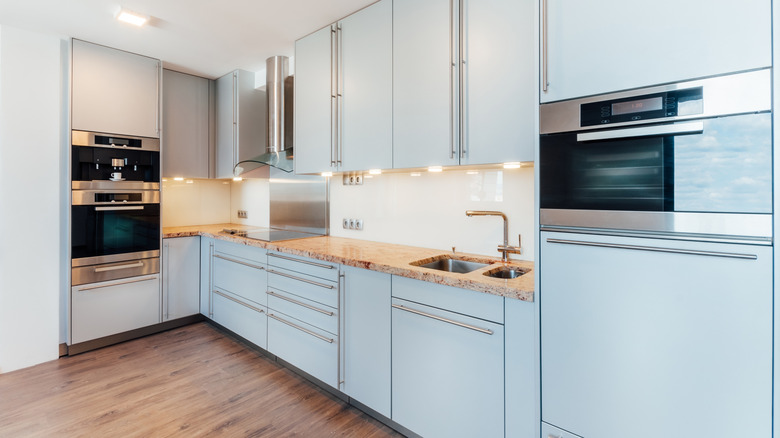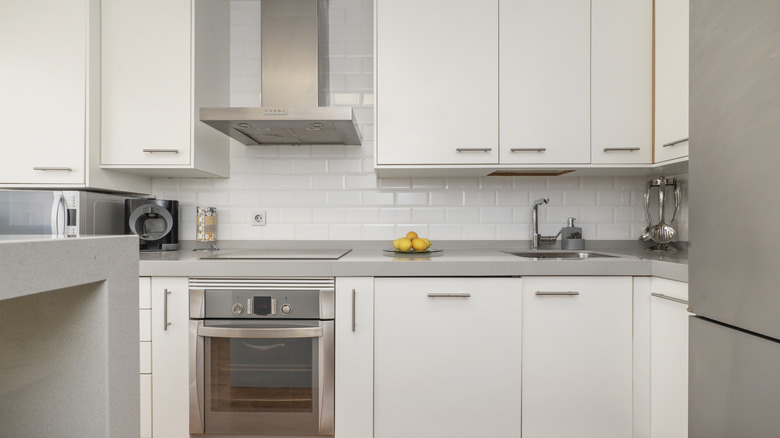Is A Warming Drawer Worth It? Here's What Homeowners Are Saying
Warming drawers aren't reserved for restaurants and multi-million-dollar homes. They're one of many trendy kitchen appliances that work in an average kitchen. But is the expense worth it? If you're a born entertainer who loves to make a good impression, you'll appreciate the ability to keep prepared food at the perfect temperature or surprise your guests with perfectly warmed plates. The investment might also be worth it for big families and people who love to bake. However, if you're on a tight budget or have a small kitchen, you might want to skip this extra appliance.
A warming drawer is just what it sounds like: a large drawer-like appliance that you can have installed in your cabinets. You'll find that the drawers have a range of settings and temperatures, often with a low temperature around 80 degrees Fahrenheit and a maximum of around 200 degrees. Many models also include moisture settings to help keep food moist and delicious. You can use the drawer for a variety of kitchen-related tasks, including proofing dough, thawing food, and slow-cooking food to prepare meals. Once the food is cooked, it stays warm and moist inside the drawer. You can also use it to keep pans and plates warm before you serve meals.
To decide if a warming drawer is worth it to you, consider how you use your kitchen and prepare food, including how often you entertain. The drawer will take up cabinet space, so factor in the size of your kitchen and how much storage space you can sacrifice. Finally, your budget may be a concern when you want to add an extra appliance that isn't a necessity.
You might want a warming drawer if you're a baker or host
Adding a warming drawer helps you set up your home for a memorable dinner party. Cook food before guests arrive and maintain its temperature until you serve it. Or prepare all courses ahead of time and serve one course at a time. If you prefer catered meals, put the food in the drawer once it's delivered. Warming drawers maintain the quality and texture of food so it won't get soggy, dried out, or overcooked. That also comes in handy if you have a busy family with members who eat at different times. The food stays fresh for stragglers who get home late.
Bakers also appreciate warming drawers not only for keeping desserts warm but also for help with proofing dough. Getting yeast dough to rise correctly is easier under ideal conditions. Your home kitchen might not be warm enough to proof dough quickly, especially when the air conditioner is running. A warming drawer maintains a consistent temperature that helps the yeast work effectively, and the enclosed design keeps cool drafts away as the dough proofs. Moisture is also important for effective proofing, so you can adjust the moisture setting on your warming drawer to help your dough rise properly.
You might also want a warming drawer if you like an restaurant-style dining experience at home. The drawer works for warming plates in addition to food. Heated plates help the food you serve retain heat longer, so you can enjoy the food as it's intended. The versatility makes the drawer a perk if you like to use a variety of cooking methods.
You might not need a warming drawer if you have a small kitchen or a tight budget
The perks of having a warming drawer are nice, but they're not necessary for the average person. You can find work-arounds for the functions of a warming drawer. For example, you can proof dough in your oven with it turned off by adding a bowl or pot of boiling water to the oven. Plus, if you don't entertain often and don't have family members eating at staggered times, you might not use the drawer often enough to justify the costs.
If you're only considering budget-friendly kitchen upgrades, you'll probably want to skip the warming drawer. Not only is the appliance expensive, but the installation is complex, which means you'll likely need to pay for professional installation, adding to your total costs. It's also an extra appliance that you need to maintain and have repaired if it stops working correctly. You can buy ranges with built-in warming drawers, but you'll likely pay more for the feature.
You might also want to skip a warming drawer if your kitchen space is limited. Warming drawers come in various sizes between 24 and 30 inches wide, which can help you find an option that fits your cabinetry. However, it's still taking up valuable storage space, which is often limited in a small kitchen. You'll want to install the warming drawer near your main food preparation area, as placing it near your oven makes it easy to transfer food. You'll also need to consider clearance requirements and necessary ventilation, which could further limit where you can place the appliance.


